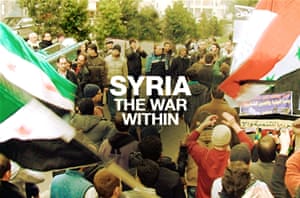| Middle East | |||||
| Red Crescent plans to enter Bab Amr | |||||
|
Medics to enter besieged district of Homs after government shelling and ground assault force rebel "tactical retreat".
Last Modified: 02 Mar 2012 08:59
|
|||||
|
The Syrian Arab Red Crescent is set to enter a besieged district of
Homs following a retreat by rebels in the face of government shelling
and a threatened ground assault. Abu Abdo Al Homsy, an activist in Homs, told Al Jazeera that residents of the Bab Amr district were awaiting the medics' arrival as intermittent shelling continued. He said government troops had been searching house by house. Bab Amr has been besieged and under fire by government forces for nearly a month and is running short of food, water and medicine, according to activists. Armed opposition fighters withdrew on Thursday, leaving an estimated 4,000 civilians waiting in their homes.
Al Jazeera's Rula Amin, reporting from Lebanon, said the government wanted to make its assault on Bab Amr, which had become a symbol of the resistance, a "decisive moment" in its offensive. "They want to tell the international community, 'We are strong, we are not going anywhere, you have to deal with us,'" she reported. But even as rebels withdrew from Homs, the conflict was likely to move elsewhere, Amin noted. "Rastan has turned into another safehaven for the rebels," she said. "The fighters who have left Bab Amr, where are they going? Will they find a place to find shelter in? .. It was a safe for the defectors." Journalists smuggled to safety On Thursday evening, rebels and activists reported that Free Syrian Army fighters had withdrawn from Bab Amr in a "tactical retreat". The fighters said they were running out of weapons and wanted to spare about 4,000 remaining civilians from more violence. They said the district was running out of food, medicine and water and was suffering communication cuts. Homs is Syria's third-largest city and before the uprising began was home to about one million people. Bab Amr had roughly 100,000 residents, but many have fled.
Spanish journalist Javier Espinosa and British photographer Paul Conroy, who was also injured in the attack, escaped to Lebanon on Wednesday. American reporter Marie Colvin and French photographer Remi Ochlik were both killed by the same shelling, and activists in Homs said they were both buried on Thursday after it was decided that there was not enough fuel to continue refridgerating their bodies indefinitely. UN demands access On Thursday, the United Nations Security Council demanded that UN humanitarian chief Valerie Amos be allowed "immediate and unhindered access" to Homs and other parts of Syria. The council's press statement was supported by Russia and China, which had previously blocked stronger resolutions on Syria.
Amos' request to visit Syria has been rejected by the government, which said the proposed date was not suitable. Council diplomats said Russia, Syria's closest ally, had urged Assad's government to approve a visit by Amos. In a concession to Russia and China, the statement called on the government and opposition to co-operate with efforts to evacuate the wounded from Syrian cities. Earlier, the two nations - joined by Cuba - voted against a UN Human Rights Council resolution that condemned Syria for "widespread and systematic violations" against civilians. The resolution also supported gathering evidence on possible crimes against humanity and other serious abuses, so that those who responsible can be held to account at a later date. The United Nations has estimated that more than 7,500 people have been killed since the anti-Assad struggle started in March 2011, when protesters took to the streets in Syria. |
|||||
|
Source:
Al Jazeera and agencies
|
|||||
|
|
Friday, March 2, 2012
 1:17 AM
1:17 AM
 Emma Blogs
Emma Blogs
Subscribe to:
Post Comments (Atom)
 RSS Feed
RSS Feed Twitter
Twitter




 Posted in
Posted in
0 comments:
Post a Comment
Tell me what's up...I would love to know..Thankies!